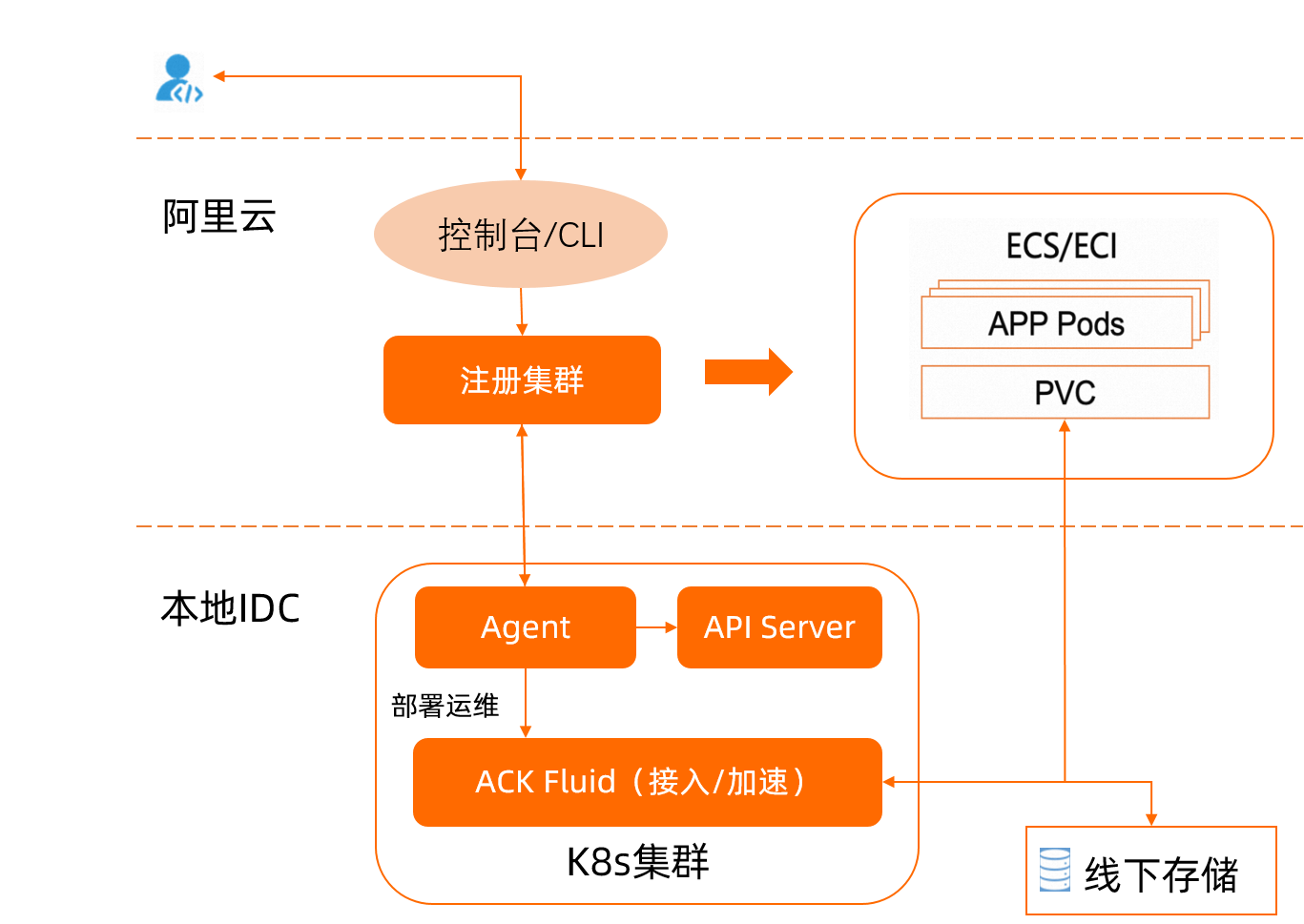Fluid是一个开源的Kubernetes原生的分布式数据集编排和加速引擎,主要服务于云原生场景下的数据密集型应用,例如大数据应用、AI应用等。除了Fluid原生集成的存储、缓存系统外,Fluid还提供了ThinRuntime CRD。ThinRuntime CRD允许用户描述任何自定义的存储系统,并将其对接到Fluid中。本文以Minio为例介绍如何在注册集群中通过Fluid管理并访问Minio存储中的数据。
实现原理
通过Fluid管理并访问线下存储的实现原理如下图所示。

前提条件
已通过容器服务Kubernetes版接入一个注册的Kubernetes集群。具体操作,请参见创建注册集群。
已通过kubectl连接注册集群。具体操作,请参见获取集群KubeConfig并通过kubectl工具连接集群。
步骤一:安装ack-fluid组件
通过onectl安装
在本地安装配置onectl。具体操作,请参见通过onectl管理注册集群。
执行以下命令,安装ack-fluid组件。
onectl addon install ack-fluid --set pullImageByVPCNetwork=falsepullImageByVPCNetwork:为可选参数,设置是否使用VPC网络拉取组件镜像。预期输出:
Addon ack-fluid, version **** installed.
通过控制台安装
登录容器服务管理控制台,在左侧导航栏选择。
在应用目录页面,搜索并选中ack-fluid。
在页面右上角,单击一键部署。
在创建面板中,选择集群,命名空间和发布名称可保持系统默认,然后单击下一步。
选择Chart 版本为当前最新版本,设置组件相关参数,然后单击确定。
步骤二:在集群中部署Minio
使用以下内容,创建minio.yaml文件。
apiVersion: v1 kind: Service metadata: name: minio spec: type: ClusterIP ports: - port: 9000 targetPort: 9000 protocol: TCP selector: app: minio --- apiVersion: apps/v1 # 1.9.0之前版本的k8s使用apps/v1beta2, 1.8.0之前的版本使用extensions/v1beta1 kind: Deployment metadata: name: minio spec: selector: matchLabels: app: minio strategy: type: Recreate template: metadata: labels: app: minio spec: containers: - name: minio image: bitnami/minio env: # 访问Minio的Access key和Secret key。 - name: MINIO_ROOT_USER value: "minioadmin" - name: MINIO_ROOT_PASSWORD value: "minioadmin" - name: MINIO_DEFAULT_BUCKETS value: "my-first-bucket:public" ports: - containerPort: 9000 hostPort: 9000执行以下命令,在集群中部署Minio。
kubectl create -f minio.yaml以上Minio配置中,Minio的用户名与密码均为minioadmin,Minio在启动时,将默认创建一个名为
my-first-bucket的存储桶。执行以下命令,在my-first-bucket中存储示例文件。
kubectl exec -it minio-69c555f4cf-np59j -- bash -c "echo fluid-minio-test > testfile" kubectl exec -it minio-69c555f4cf-np59j -- bash -c "mc cp ./testfile local/my-first-bucket/" kubectl exec -it minio-69c555f4cf-np59j -- bash -c "mc cat local/my-first-bucket/testfile" fluid-minio-test
步骤三:准备包含Minio Fuse客户端的容器镜像
Fluid会把ThinRuntime中Fuse所需的运行参数、Dataset中描述数据路径的挂载点等参数传入到ThinRuntime Fuse的Pod容器中。在容器内部,用户需要执行参数解析脚本,并将解析完的运行时参数传递给Fuse客户端程序,由客户端程序完成Fuse文件系统在容器内的挂载。因此,使用ThinRuntime CRD描述存储系统时,需要使用特制的容器镜像,镜像中需要包括以下两个程序。
Fuse客户端程序:本示例选择S3协议兼容的goofys客户端连接并挂载minio存储系统。
Fuse客户端程序所需的运行时参数解析脚本:您可以通过自定义如下Python脚本fluid-config-parse.py。
import json with open("/etc/fluid/config.json", "r") as f: lines = f.readlines() rawStr = lines[0] print(rawStr) script = """ #!/bin/sh set -ex export AWS_ACCESS_KEY_ID=`cat $akId` export AWS_SECRET_ACCESS_KEY=`cat $akSecret` mkdir -p $targetPath exec goofys -f --endpoint "$url" "$bucket" $targetPath """ obj = json.loads(rawStr) with open("mount-minio.sh", "w") as f: f.write("targetPath=\"%s\"\n" % obj['targetPath']) f.write("url=\"%s\"\n" % obj['mounts'][0]['options']['minio-url']) if obj['mounts'][0]['mountPoint'].startswith("minio://"): f.write("bucket=\"%s\"\n" % obj['mounts'][0]['mountPoint'][len("minio://"):]) else: f.write("bucket=\"%s\"\n" % obj['mounts'][0]['mountPoint']) f.write("akId=\"%s\"\n" % obj['mounts'][0]['options']['minio-access-key']) f.write("akSecret=\"%s\"\n" % obj['mounts'][0]['options']['minio-access-secret']) f.write(script)该Python脚本将按以下步骤执行。
读取
/etc/fluid/config.json文件中的JSON字符串,Fluid会将Fuse客户端挂载所需的参数存储并挂载到Fuse容器的/etc/fluid/config.json文件。解析JSON字符串,从中提取Fuse客户端挂载所需的参数。例如,上述示例中的
url、bucket、minio-access-key、minio-access-secret等参数。所需参数提取后,输出挂载脚本到mount-minio.sh文件中。
使用如下Dockerfile制作镜像。
此处选择包含goofys客户端程序的镜像(例如cloudposse、goofys)作为Dockerfile的基镜像。
FROM cloudposse/goofys RUN apk add python3 bash COPY ./fluid-config-parse.py /fluid-config-parse.py执行以下命令,构建并推送镜像到镜像仓库。
IMG_REPO=<your image repo> docker build -t $IMG_REPO/fluid-minio-goofys:demo . docker push $IMG_REPO/fluid-minio-goofys:demo
步骤四:创建ThinRuntimeProfile
ThinRuntimeProfile是一种Cluster-level的Fluid CRD资源,它描述了一类需要与Fluid对接的存储系统的基础配置(例如容器镜像信息、Pod Spec描述信息等)。创建Fluid Dataset和ThinRuntime CR用于挂载Minio存储系统之前,需要先创建ThinRuntimeProfile CR资源。
使用以下内容,创建profile.yaml文件。
apiVersion: data.fluid.io/v1alpha1 kind: ThinRuntimeProfile metadata: name: minio-profile spec: fileSystemType: fuse fuse: image: $IMG_REPO/fluid-minio-goofys imageTag: demo imagePullPolicy: IfNotPresent command: - sh - -c - "python3 /fluid-config-parse.py && chmod u+x ./mount-minio.sh && ./mount-minio.sh"执行以下命令,创建ThinRuntimeProfile。
kubectl create -f profile.yaml
步骤五:创建Dataset和Runtime
执行以下命令,将访问Minio所需的访问凭证存储于Secret。
kubectl create secret generic minio-secret \ --from-literal=minio-access-key=minioadmin \ --from-literal=minio-access-secret=minioadmin使用以下内容,创建dataset.yaml文件。
此YAML文件包含创建Dataset和ThinRuntime CR,通过创建Dataset和ThinRuntime CR用于挂载访问Minio存储系统中的数据。
apiVersion: data.fluid.io/v1alpha1 kind: Dataset metadata: name: minio-demo spec: mounts: - mountPoint: minio://my-first-bucket # minio://<bucket name> name: minio options: minio-url: http://minio:9000 # minio service <url>:<port> encryptOptions: - name: minio-access-key valueFrom: secretKeyRef: name: minio-secret key: minio-access-key - name: minio-access-secret valueFrom: secretKeyRef: name: minio-secret key: minio-access-secret --- apiVersion: data.fluid.io/v1alpha1 kind: ThinRuntime metadata: name: minio-demo spec: profileName: minio-profile类别
参数
说明
示例值
Dataset
mountPoint
指定所需访问的数据桶。
my-frist-bucket
minio-url
指定Minio在集群中可访问的URL。
http://minio:9000
ThinRuntime
profileName
指定已创建的ThinRuntimeProfile。
minio-profile
执行以下命令,部署Dataset CR和ThinRuntime CR。
kubectl create -f dataset.yaml执行以下命令,查看minio-demo状态。
kubectl get dataset minio-demo预期输出:
NAME UFS TOTAL SIZE CACHED CACHE CAPACITY CACHED PERCENTAGE PHASE AGE minio-demo N/A N/A N/A Bound 2m18s预期输出中Dataset和Phase状态变为Bound,表明Dataset可正常挂载使用。
步骤六:创建Pod访问Minio存储系统中的数据
使用以下内容,创建pod.yaml文件。
该Pod用于访问Minio中的数据。
apiVersion: v1 kind: Pod metadata: name: test-minio # 如果云上为ECI节点,需要添加以下标签: # labels: # alibabacloud.com/eci: true # alibabacloud.com/fluid-sidecar-target: "eci" spec: containers: - name: nginx image: nginx:latest command: ["bash"] args: - -c - ls -lh /data && cat /data/testfile && sleep 3600 volumeMounts: - mountPath: /data name: data-vol volumes: - name: data-vol persistentVolumeClaim: claimName: minio-demo使用以下内容,部署Pod。
kubectl create -f pod.yaml执行以下命令,查看数据访问结果。
kubectl logs test-minio预期输出:
total 512 -rw-r--r-- 1 root root 17 Dec 15 07:58 testfile fluid-minio-test预期输出表明,名为test-minio的Pod可正常访问Minio存储系统中的数据。
(可选)步骤七:清理环境
当不再需要访问云下存储时,您需要执行以下命令清理环境。
kubectl delete -f pod.yaml
kubectl delete -f dataset.yaml
kubectl delete -f profile.yaml
kubectl delete -f minio.yaml